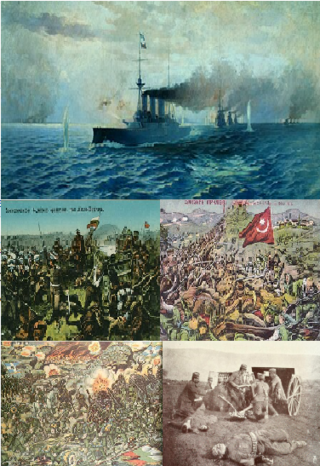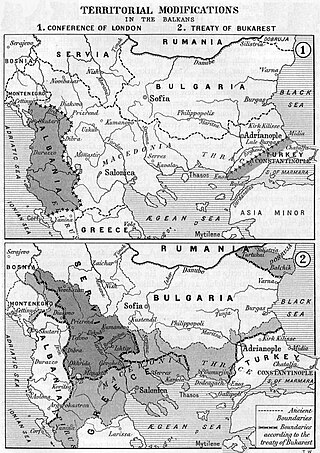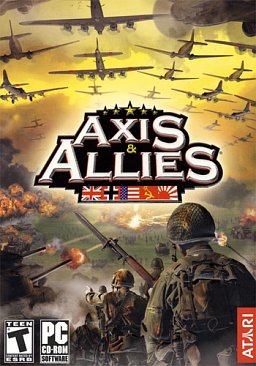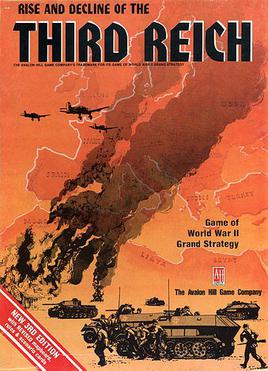
The Balkan Wars were a series of two conflicts that took place in the Balkan states in 1912 and 1913. In the First Balkan War, the four Balkan states of Greece, Serbia, Montenegro and Bulgaria declared war upon the Ottoman Empire and defeated it, in the process stripping the Ottomans of their European provinces, leaving only Eastern Thrace under the Ottoman Empire's control. In the Second Balkan War, Bulgaria fought against the other four original combatants of the first war. It also faced an attack from Romania from the north. The Ottoman Empire lost the bulk of its territory in Europe. Although not involved as a combatant, Austria-Hungary became relatively weaker as a much enlarged Serbia pushed for union of the South Slavic peoples. The war set the stage for the Balkan crisis of 1914 and thus served as a "prelude to the First World War".

The Central Powers, also known as the Central Empires, were one of the two main coalitions that fought in World War I (1914–1918). It consisted of Germany, Austria-Hungary, the Ottoman Empire, and Bulgaria; this was also known as the Quadruple Alliance.

The Triple Alliance was a defensive military alliance between Germany, Austria-Hungary, and Italy. It was formed on 20 May 1882 and renewed periodically until it expired in 1915 during World War I. Germany and Austria-Hungary had been closely allied since 1879. Italy was looking for support against France shortly after it lost North African ambitions to the French. Each member promised mutual support in the event of an attack by any other great power. The treaty provided that Germany and Austria-Hungary were to assist Italy if it was attacked by France without provocation. In turn, Italy would assist Germany if attacked by France. In the event of a war between Austria-Hungary and Russia, Italy promised to remain neutral. The existence and membership of the treaty were well known, but its exact provisions were kept secret until 1919.

Axis & Allies is a series of World War II strategy board games. The first version was initially published in 1981 and a second edition known colloquially as Axis & Allies: Classic was published in 1984. Played on a board depicting a Spring 1942 political map of Earth divided by territories, players take the role of one or more of the five major belligerents of World War II: the Axis powers of Germany and Japan; and the Allied powers of the Soviet Union, the United Kingdom, and the United States. Turns rotate among these belligerents, who control armies of playing pieces with which they attempt to capture enemy territories, with results determined by dice rolls.

The Treaty of Bucharest was concluded on 10 August 1913, by the delegates of Bulgaria, Romania, Serbia, Montenegro and Greece. The Treaty was concluded in the aftermath of the Second Balkan War and amended the previous Treaty of London, which ended the First Balkan War. About one month later, the Bulgarians signed a separate border treaty with the Ottomans, who had regained some territory west of the Enos-Midia Line during the second war.

Axis & Allies: Europe is a strategic board wargame produced by Hasbro under the Avalon Hill name brand. Designed by Larry Harris, who designed the original Axis & Allies board game, Axis & Allies: Europe focuses game play on the European Theatre of World War II.

The Eastern Front or Eastern Theater of World War I was a theater of operations that encompassed at its greatest extent the entire frontier between Russia and Romania on one side and Austria-Hungary, Bulgaria, the Ottoman Empire, and Germany on the other. It stretched from the Baltic Sea in the north to the Black Sea in the south, involved most of Eastern Europe, and stretched deep into Central Europe as well. The term contrasts with the Western Front, which was being fought in Belgium and France.
Axis & Allies: Pacific is a strategy board game produced by Hasbro under the Avalon Hill name brand. Released on July 31, 2001 and designed by Larry Harris, the designer of the original Axis & Allies game, Axis & Allies: Pacific allows its players to recreate the Pacific Theater of World War II.
Attack! is a board game created by Glenn Drover and published by Eagle Games in 2003. It is a light war game that is midway between Risk and Axis and Allies in complexity. The game is loosely set in the 1930s and includes plastic pieces featuring tanks, planes, infantry, and artillery. Attack! won the Origins Award for Best Historical Game 2003.
Axis & Allies: D-Day is the fifth version of the strategy board-game Axis & Allies, released on June 11, 2004 as a celebration of the 60th anniversary of D-Day during World War II. It lets two to three players recreate Operation Overlord or D-Day scenarios during June–July 1944. It was designed by Larry Harris and developed by Mike Selinker. The game won the Origins Award Gamers’ Choice Award 2004.

Axis & Allies is a real-time strategy World War II video game developed by TimeGate Studios and published by Atari for Microsoft Windows. The game was released on November 2, 2004. It is based on the board game series Axis & Allies from Milton Bradley and also on TimeGate's Kohan series. Set in the years after Japan and the United States entered into the war, the game allows the player to act as a World War II commander to build military forces to fight against other generals, using military units and technologies from the war. The player is able to rewrite and recreate the history of World War II.

Rise and Decline of the Third Reich or more commonly Third Reich is a grand strategy wargame covering the European theater of World War II, designed by John Prados and released in 1974 by Avalon Hill. Players take on the roles of major powers—Germany, Italy, United Kingdom, France, the Soviet Union, and the United States—from 1939 to 1946.

Axis & Allies is a 1998 computer wargame closely based on the Axis and Allies: Classic board game.
Axis & Allies: Battle of the Bulge is a board game which depicts the Battle of the Bulge, the "last-ditch" offensive of World War II by Nazi Germany. It is similar to Axis & Allies: D-Day in that the game is played on a tactical rather than strategic level, although the gameplay is radically different from D-Day or any other previous Axis and Allies game. It is designed by Larry Harris, and published by Avalon Hill.

Paths of Glory: The First World War, 1914–1918 is a strategy board wargame, designed in 1999 by the six-time Charles S. Roberts Awards winner Ted Raicer and published by GMT Games. It covers World War I from its outbreak to the 1918 Armistice, or based on the progress of the game a hypothetical later ending of the war in early 1919, possibly due to exhaustion of Europe. The game is played on a map of Europe and the Middle East as the game board.

While Poland did not exist as an independent state during World War I, its geographical position between the fighting powers meant that much fighting and terrific human and material losses occurred on the Polish lands between 1914 and 1918.

Axis & Allies: Pacific 1940 is a board game created by Larry Harris and published by Avalon Hill as part of the Axis & Allies family of games. It is considered to be a revision of Harris' earlier game, Axis & Allies: Pacific. Among the major changes from Pacific was the incorporation of newer rules from newer Axis & Allies revisions, as well as features exclusive to this game.

Axis & Allies: Europe 1940 is a 2010 board wargame simulating the European Theatre of World War II at the strategic level.
Age of Napoleon is a 2003 war and strategy board game created in collaboration between Mayfair Games and Phalanx Games. It focuses on the Napoleonic Wars in Europe from 1805 to 1815. The game's designer is Renaud Verlaque and its artist is Franz Vohwinkel.

World War I: 1914–1918 is a board wargame published by Simulations Publications Inc. (SPI) in 1975 that simulates the First World War at a strategic level. Contemporary critics gave the game positive reviews, noting that its ingenious rules, short playing time, and emphasis on resource management made the game highly playable.

















